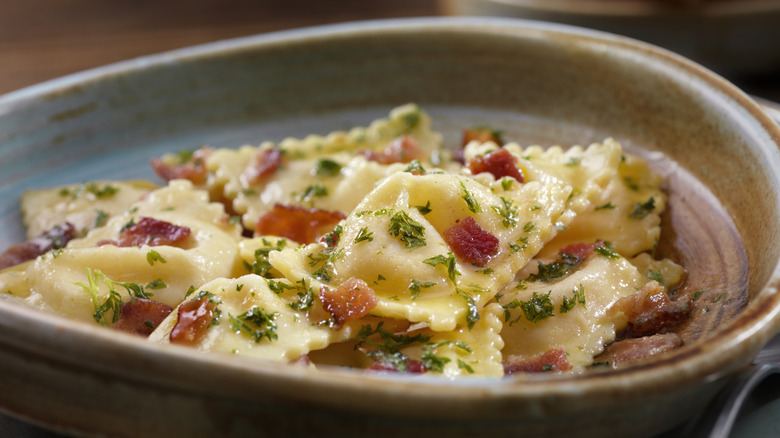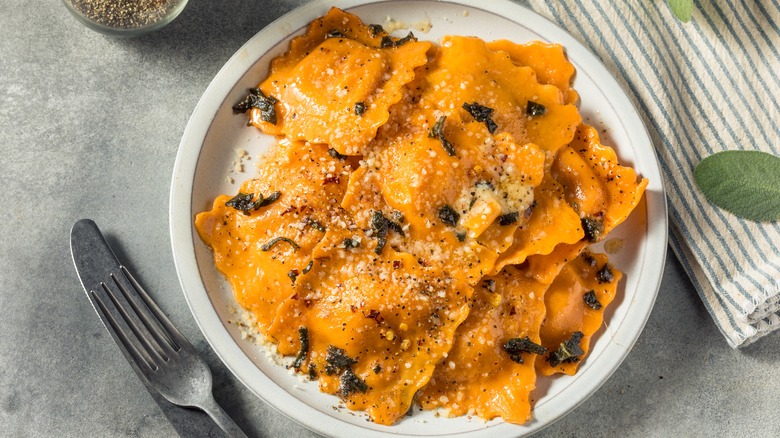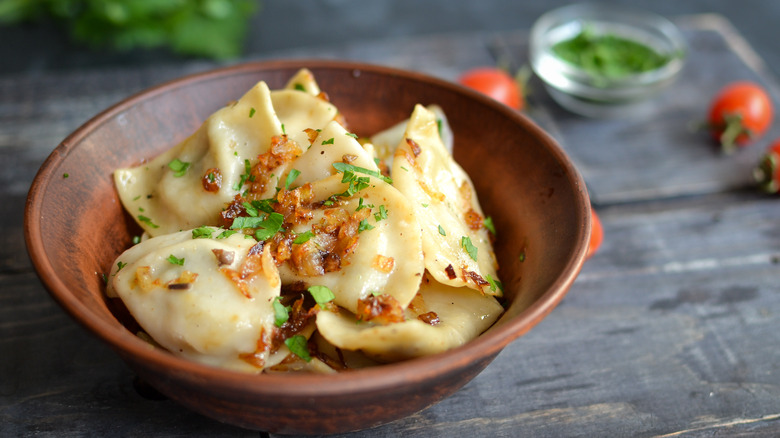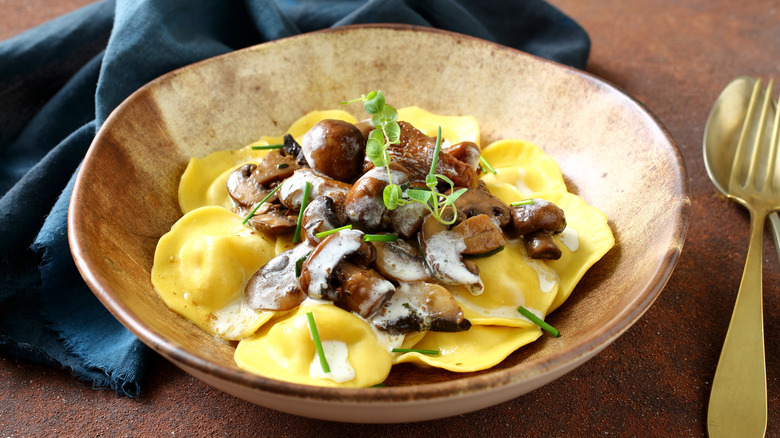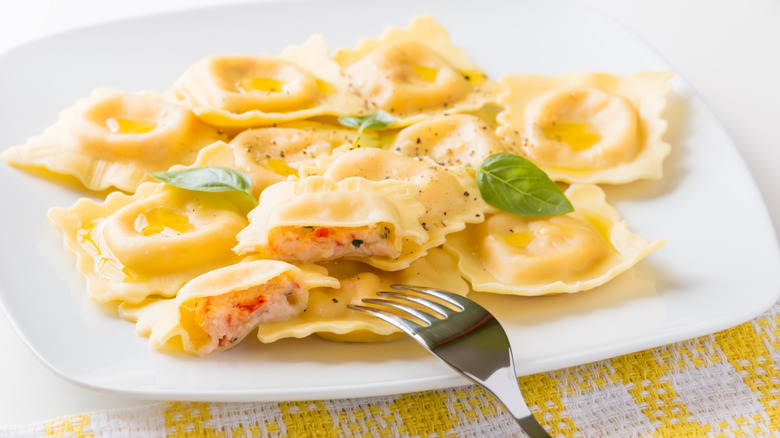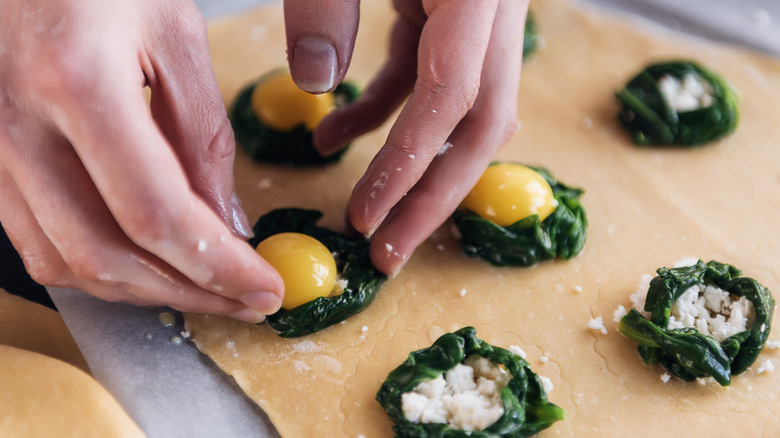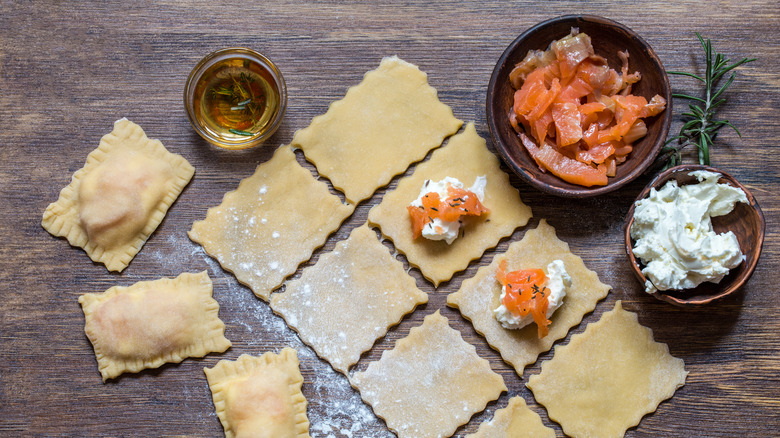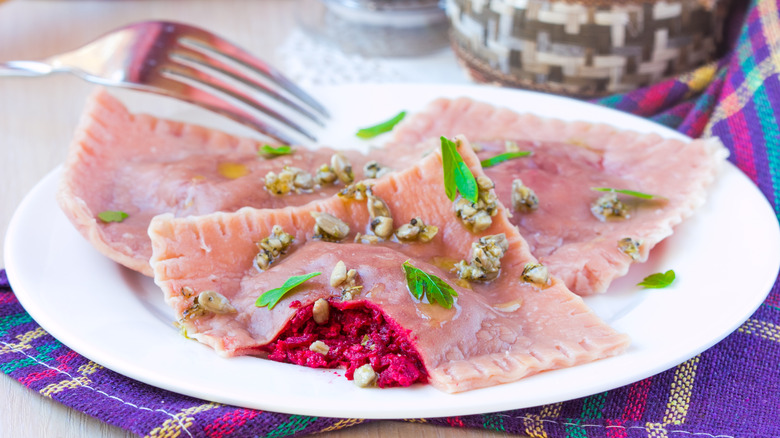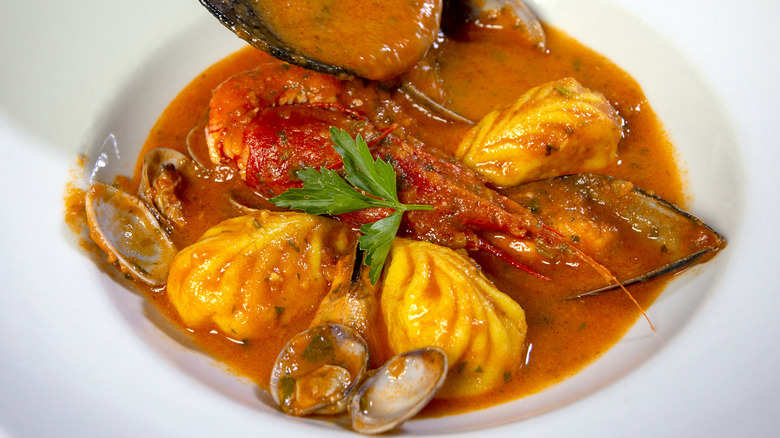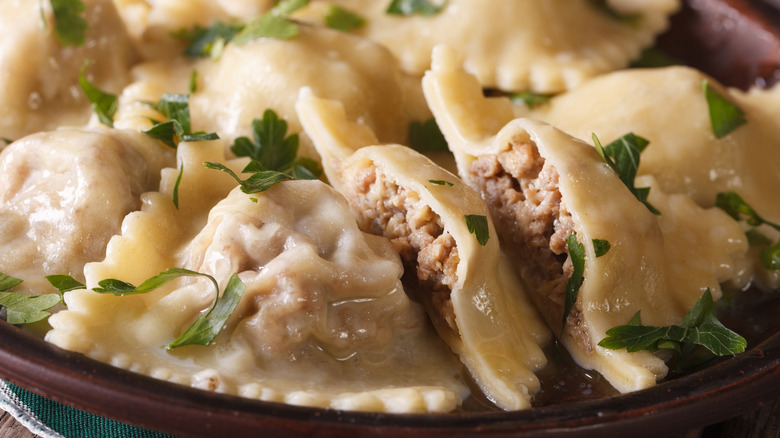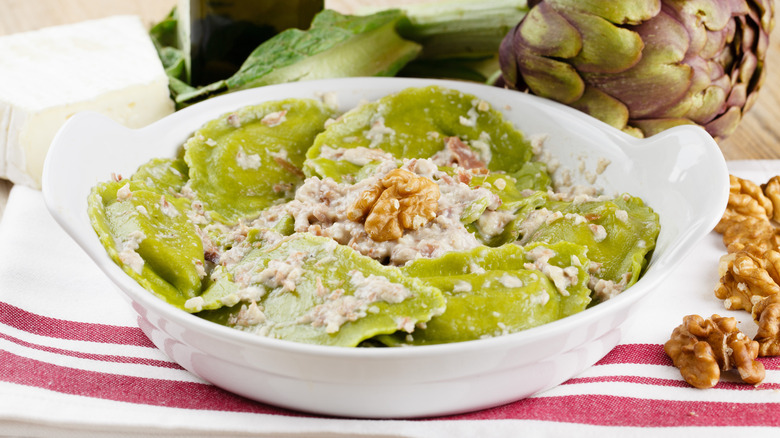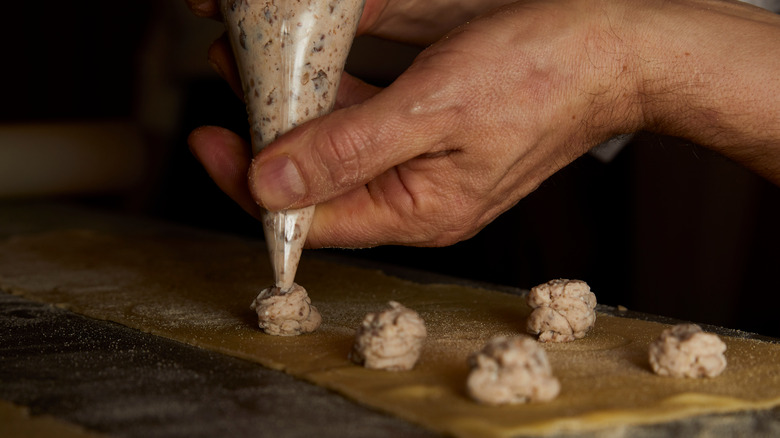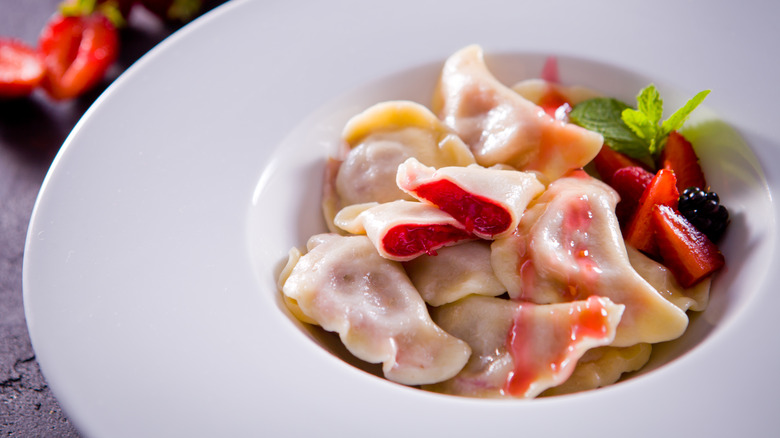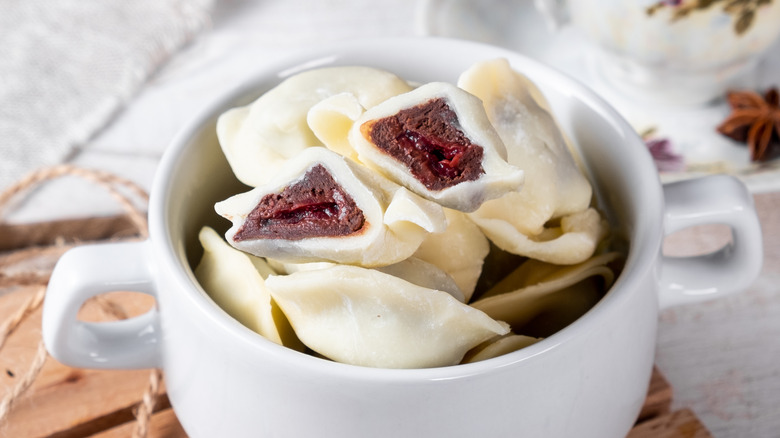The Best Stuffed Pasta Fillings That Aren't Just Cheese
Pasta is one of the world's most wonderful creations. The simple combination of flour, water, salt, and perhaps some eggs originated as a frugal dish, but the no-frills approach and comforting nature launched it into culinary stardom. Pasta has become an international pantry staple as wherever you go, the word no longer requires an explanation or translation.
In the pasta domain, Italy is usually considered the ultimate destination. It is a place where the dish was popularized and that safeguards hundreds of local pasta varieties. It's hard to say how many pasta shapes currently exist, but stuffed pasta has an obvious advantage over all other forms. As it is already flavored, it does not require much dressing up. A simple drizzle of melted butter can sometimes be enough. Among stuffed pasta varieties, ravioli and all its variations reign supreme, and cheese is the most common option when it comes to fillings. Though cheese and pasta may be a match made in culinary heaven, numerous other ingredients make fantastic pasta fillers.
If you are tired of the stereotypical, ricotta-stuffed ravioli, browse the list to find inspiration for your next pasta night. This eclectic list of savory and sweet ingredients will seriously diversify your stuffed pasta game. Some are more common than others, but all have fantastic potential. Along with each stuffing, we have suggestions for the best pasta sauce pairings.
Pumpkin
We've already perfected pumpkin's use in hearty soups and delectable pies, but this aromatic veggie can also be turned into a creamy pasta filling. You can use already prepped pumpkin puree or a whole pumpkin that you bake and turn into a creamy mash. From there, you can season it according to your taste and then use it as a filling inside any pasta shape. This is the filling you want to start making in the fall when pumpkin season begins and the crisp weather starts dictating the need for heartier flavors.
Though it is not internationally familiar, pumpkin is one of the traditional pasta fillings used in Italy. It is usually associated with the north of the country, and the most popular version comes from Mantua, Lombardy. In Mantua, the pasta is filled with an aromatic mix of pumpkin puree, crushed amaretti cookies, and freshly grated cheese. The combination is made more unique with the addition of mostarda — a fruit-like preserve flavored with mustard — and a generous mix of spices that includes nutmeg, which adds a robust aromatic note. Despite some sweet ingredients, this is a savory dish usually eaten as a starter and often made for Christmas. Similar versions come from Veneto and Ferrara.
In the classic version, this stuffed pasta is served with butter and sage sauce. If you try a different version, keep it simple, as the filling is powerful enough and does not call for any more dominant flavors.
Potato
Though we were raised on the idea that carbs on carbs is not an accepted culinary practice, there are some exceptions where this rule should be broken. This pasta and filling combo is one of them. Potatoes are not typically associated with pasta or commonly made into a pasta filling, but there is no reason this popular tuber should be shunned in this combination. You can effortlessly turn the potatoes into a creamy blend that can make a fantastic pasta filling. Because they are so neutral, you can easily play with add-ons and build the flavor profile with various spices or herbs.
Perhaps unsurprisingly, Italians cracked this code a long time ago, and several traditional dishes use potatoes as a pasta filling. One of the most popular potato-stuffed versions comes from Vernante, Piedmont, in which round-shaped pasta is stuffed with mashed potatoes, leeks, spinach, and a touch of Parmigiano-Reggiano. The flavors are brightened up with a touch of nutmeg and fresh parsley. Tuscany has several versions of potato ravioli (or tortelli as they are locally known) with the most popular coming from Mugello, where the filling combines mashed potatoes, garlic, and parsley. The ravioli are slightly larger and typically come dressed up with butter and sage. Tortelli alla lastra is one of the unique versions as the ravioli are baked rather than boiled. The fillings are versatile but usually combine potatoes with pumpkin, bacon, and various aromatics.
Mushroom
Mushroom sauce and pasta make a classic combination, so it is not surprising that mushrooms can be easily turned into a pasta filling. As there are many mushroom varieties, you can tweak most recipes and make the flavor combination that will fit your preference. Mushrooms are quite aromatic, so pairing them with a more neutral, preferably mild-flavored cheese such as ricotta or even a fatty mascarpone is always recommended. If you are feeling adventurous, perhaps go for the tangy goat cheese. Additionally, you can add garlic and dry or fresh herbs. Of course, you can also rely exclusively on the mushrooms and make something like a mushroom-based tapenade.
You want to go with a creamy, butter-based sauce with mushroom-stuffed pasta. Infuse it with herbs as they will perfectly balance out the sometimes robust and earthy mushroom character — think of sage or rosemary as ideal partners. If you want an extra mushroom kick, you can add finely sliced mushrooms to the sauce. Freshly grated cheese, preferably something equally potent like the legendary Parmegiano-Reggiano, would be a nice final touch with this autumnal dish. If you want to accentuate the mushrooms and give the dish a more luxurious feel, it's best to top it with freshly grated truffle if it's in season.
Lobster
Lobster is a less traditional and more luxurious pasta filling that you may find on the menus of contemporary fine-dining restaurants, but you can also try to recreate it as a homemade ravioli version. This filling requires cooked lobster meat. Though the tail is generally labeled as the prime piece, reserve it for other, less processed dishes and use the less popular parts to make the ravioli filling. For the easiest homemade version, you can skip the cooking part and buy fresh or cooked pre-packed lobster meat.
You want the lobster to remain dominant in the filling, but it will need some creamy addition, and cheese would be the most obvious choice. You can mix lobster meat with crab and use light, refreshing seasonings. Salt, pepper, mildly aromatic herbs, and a whiff of grated lemon zest would be enough.
As this is such a luxurious filling, it does not call for any elaborate or overly complicated sauces. You want the lobster meat to shine through, so it's best to pair it with something neutral, such as cream and butter sauces — brown butter would be a great option here — or some mild-flavored cheese dressing. Tomatoes, garlic, and herbs would complement it nicely, too. Stay clear of potent mushroom or truffle combinations that may smother the filling. If you used whole lobster, preserve some of the cooking liquid and use it as the base for the sauce.
Egg yolk
Whole egg yolks stuffed inside pasta dough may not be one of the ancient Italian dishes, but this unusual creation was born in Italy. It was invented at the Ristorante San Domenico in Imola, a Michelin-starred establishment where cooking reflects tradition but keeps the menu vibrant and innovative. This specialty was first whipped up in 1974. The idea was built by Nino Bergese and Valentino Marcattilii, two legendary Italian chefs who collaborated at San Domenico. The filling features a whole, plump egg yolk coated with a smooth ricotta and spinach blend.
The egg yolk filling is creamy and delicious and does not require many accessories. The dish should be served with simple sauces that will accentuate the richness of the filler. Salt and freshly ground pepper with melted butter or a touch of olive oil would be enough. For the ultimate luxury experience, freshly grated truffles would be the ideal partner — just the way it is still served at San Domenico. If you want to recreate it at home, you can even go with quail yolks, which will result in a more elegant version. This pasta should never be overcooked as you want to see the yolk ooze as you cut into it.
Smoked salmon
Though fish is not often paired with pasta, smoked salmon is one of the more common seafood options. Apart from its use in sauces, it is also commonly turned into a pasta filling. As smoked salmon is usually cured before it is smoked, no further processing is necessary, which is quite convenient for making pasta fillings. Smoked salmon should be finely chopped and is usually combined with a creamy base. Cheese is the easiest and most common option, but cream and even mashed potatoes can make a wonderful choice that will hold the filling together. Seasonings should be classic, but a touch of lemon would brighten the whole dish.
As smoked salmon is not traditional in Italy, there are no rules for sauces. The salmon gives the dish a pleasant, smoky character that can pair nicely with a whole array of dressings. Anything creamy or made with butter, olive oil, or egg yolks would go well. You can add some crunch or pair the pasta with dill, which naturally complements salmon. If you add lemon to the filling, you can also follow up with a zesty, lemon-flavored sauce.
Beetroot
Though this might sound like quite an unusual combination, beetroot is a traditional pasta filling in Italy. Though it is not standard for the entire country, if you travel through the north, you might get to try the local pasta variety that uses mashed beetroot as the filling of choice. Locally known as casunziei all'ampezzana — casunziei is the regional name for stuffed pasta formed into a half-moon shape — this pasta variety hails from Cortina d'Ampezzo, a city nestled in the mountainous Dolomites. The filling is made with cooked beetroot that is blended into a creamy mash and combined with cheese (usually ricotta), eggs, and seasonings. In the less traditional version, pasta dough can be infused with beets for a double dose of flavor and a pop of color.
This stuffed pasta is traditionally served with a butter-based sauce, enriched with grated Parmesan and sprinkled with poppy seeds that add a delightful crunch. Even if you combine it with other ingredients, beetroot retains a deep, earthy flavor, and this brawny richness always succeeds in coming through. That's why this pasta calls for lighter and creamier sauces without potent or daring flavors.
Fish and seafood
Though fish and shellfish are not common in pasta fillings, there is no legitimate reason to ignore them. Traditional Italian cuisine features several stuffed pasta varieties that turn fish and other seafood into delectable pasta fillings. The easiest route to go for is with baked fish. If using whole fish, the meat should be carefully removed and cleaned to make the base for the filling. As fish can often be flakey, it should be mixed with a creamy flurry made with any combination of eggs, cheese, and seasonings. The best option is to go with white-fleshed varieties such as bass or bream, and for the deluxe version, add some sweet, juicy shrimp. In Italy, pasta stuffed with fish or seafood is usually referenced as ravioli di pesce or ravioli di mare.
Pasta filled with fish and seafood finds an ideal partner in tomato-based sauces. Ideally, the sauce will be enriched with seafood stock, and for a more elaborate meal, it will come packed with seafood delicacies such as mussels, shrimp, or clams. For the white sauce version, just remove the tomatoes and flavor the stock with olive oil and white wine.
Meat
Meat is one of the more common pasta fillers. The possibilities and the variations are seemingly endless, and most types and cuts of meat can be easily turned into a pasta filling — pork, beef, and chicken are all good choices. The meat can be whole or minced, and it is usually pre-cooked. If you have meaty leftovers, stuffed pasta is probably the best way to repurpose it. Shred the meat and then act as if it's a classic filling. Combine it with cheese, eggs, or veggies and enrich the mixture with herbs and spices. Meat should be seasoned well, so expect more flavor than your standard cheese ravioli.
In traditional Italian cuisine, meat-filled pasta comes in many shapes and sizes. Agnolotti del plin is the version that hails from Piedmont. Easily recognized for its small size and unique shape, these pasta pockets are usually filled with braised meat and veggies. Sausage and ground meat are combined to make a filling for giant-sized ravioli alla scapolese, a traditional Carnival dish from Molise.
There are no limits when it comes to sauces for most meat-filled pasta. The meaty combinations are usually sturdy enough to work well with more aromatic sauces, but they also pair nicely with mildly flavored varieties such as the classic sage and butter combo. Mushroom sauces or meat ragù — as it is traditionally done in Genoa — are great options if you want heartier interpretations.
Artichoke
Artichokes are often featured in traditional Italian cooking but are not commonly made into pasta fillings. However, if properly prepped, they can make a beautiful, vegetable-based filler for ravioli.
As artichokes are pretty brittle and hard, they need to be cooked down. When they become soft and tender, blitz them in the food processor until you get a smooth, fragrant paste. If you prefer more texture and chew, do not over-process the mix. Artichokes would pair nicely with many herbs — thyme would be an especially lovely addition — and would profit from sauteed onions and garlic. Freshly grated cheese, a sprinkle of olive oil, and a squeeze of lemon juice would be enough to complete the filling. If you require more creaminess, add mascarpone or ricotta.
You want this stuffed pasta adorned with a simple, unpretentious sauce. The classic butter and sage combination would be the obvious choice here, but perhaps a more complex, brown butter version would be even better. Replace sage with thyme if you used it for the filling and grate some fresh cheese before serving. A sprinkle of crushed nuts would be a fantastic finishing touch to this dish.
Chestnut
Chestnuts are one of the unfairly underestimated cooking ingredients. These nuggets pack a lot of flavor and have a distinctive nutty taste and aroma that is transplanted into every dish where it is used. Cleaning chestnuts can be a drag, but if you make pasta, go for the pre-packed chestnut purees that will easily transform into a supple stuffing. Chestnut filling will require a creamy base that is easily attained with the addition of soft cheese.
This is one of those pasta fillings where cream-based sauces would be the ultimate option. This pasta is packed with earthy flavors, so you want something to balance it out. The dish does call for nuanced savoriness and crunch, so it's best to dress it up with fried ham or bacon bits. Chestnut ravioli have an additional sweet version you will usually encounter during Carnival. In this rendition, the filling is packed inside fried dough, resulting in a crunchy and crispy delicacy hiding a sweet, chestnut-based combination.
Fruit jam
Though we rarely think of pasta in the realm of desserts, pasta dough is usually incredibly neutral and can be steered in a sweet direction. Along with sweetened ricotta, the easiest way to make a sweet pasta filling is to opt for fruit jams. These fruity preserves are already sweetened and, in most cases, have an ideal consistency ready to be turned into a pasta filling. If you try to make it at home, feel free to choose your favorite variety, but make sure that the consistency of the jam is sturdy enough to hold shape and not slide off the pasta sheet immediately.
Some traditional Italian versions will pair the jams with other ingredients for more creative takes. A unique, fried version from Abruzzo that's typically served on special occasions usually employs thick grape jam, almonds, and chocolate. Cjarsons pasta from Friuli also has a sweet, jammy variation that includes quirky additions such as crushed cookies, nuts, cinnamon, and cocoa. These sweet, jam-packed versions are often reserved for Carnival or other celebrations. Many of them, in line with Carnival traditions, are fried. Instead of jams, a great alternative is to fill the pasta with fresh or stewed fruit.
Chocolate
Chocolate-filled pasta is not something that you will find in traditional cookbooks. But, because Italy is the land of pasta and also makes the best chocolate spread, the combination suddenly does not seem so unreasonable. You will sometimes see similar flavors in the large group of the so-called sweet ravioli that are traditionally fried and enjoyed during Carnival. However, you can use the classic approach and boil the chocolate-filled bites. Either way, the final result should be gooey and utterly delicious. Use homemade or storebought chocolate spreads and adjust flavorings and additions to your preference.
As this is a pasta filling that completely steps away from tradition, you can play with flavors, garnishes, and sauces. With all these dark elements, a subtly tart, fruit-based sauce would be the perfect match, but a dollop of whipped cream garnished with fresh mint sounds equally good. Caramel and toasted nuts are also some of the options worth considering.
For the ultimate chocolate version, you can also use cocoa inside the pasta dough. It will lend a more chocolatey flavor and give those pasta pockets an intriguing, dark color.
